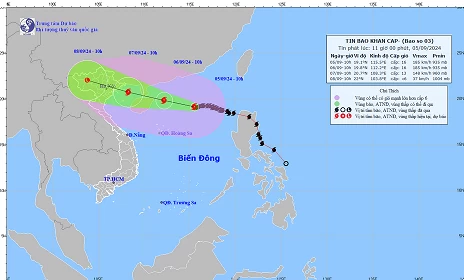
PM Pham Minh Chinh signed a dispatch demanding urgent response to super Typhoon Yagi
Latest
 |
| The predicted path of Typhoon Yagi (Source: National Centre for Hydro-Metorological Forecasting) |
The dispatch was sent to leaders of provinces and cities along the coast from the northern to the central regions, namely Quang Ninh, Hai Phong, Thai Binh, Nam Dinh, Ninh Binh, Thanh Hoa, Nghe An, Ha Tinh, Quang Binh, Quang Tri, Thua Thien - Hue, Da Nang, Quang Nam, Quang Ngai, and Binh Dinh, along with the inland northern localities of Lang Son, Cao Bang, Bac Kan, Thai Nguyen, Ha Giang, Lao Cai, Yen Bai, Tuyen Quang, Phu Tho, Vinh Phuc, Dien Bien, Lai Chau, Son La, Hoa Binh, Hanoi, Ha Nam, Hung Yen, Hai Duong, Bac Ninh, and Bac Giang.
It was also sent to the ministers of national defence, public security, natural resources and environment, agriculture and rural development, industry and trade, transport, construction, foreign affairs, information and communications, education and training, health, and culture, sports and tourism.
It noted that on September 5 morning, Yagi, the third to enter the East Sea this year, strengthened into a super typhoon with the fastest wind speed near its eye at Level 16, gusting up to over Level 17.
The storm is predicted to directly impact the Gulf of Tonkin from September 6 morning, sustaining the fastest wind speed of Level 13 - 14, with gusts of up to Level 16. It will directly affect the mainland in the northeastern and north-central regions from September 6 night, carrying winds of up to Level 10 - 12 with gusts of Level 13 - 14. It is likely to affect deep into the mainland and trigger strong winds, rising water and big waves at sea and coastal areas, along with widespread downpours in the mainland.
Given Yagi’s great intensity, considerable risks, and complicated developments, the Prime Minister demanded the abovementioned ministers as well as the secretaries of the Party Committees and chairpersons of the People’s Committees of the localities to boost leadership, direction, examination, and drastic, timely, and effective implementation of the highest-level response measures to guarantee life safety for people, especially children and vulnerable groups, while minimising property damage for both people and the State.
Leaders of the localities were asked to postpone non-urgent meetings to mobilise the entire political system for storm response, he said, ordering members of the Party Committees’ Standing Boards and permanent members of the People’s Committees to be deployed to key places to promote response measures.
Focus must be put on ensuring safety for people, vessels, and vehicles operating at sea, particularly in the Gulf of Tonkin and coastal areas from central Ha Tinh province to northwards; in shelter areas; along with dangerous areas, including those susceptible to flooding, landslides, and flash floods. Local leaders must also ensure safety for dykes, dams, reservoirs, and traffic, as well as minimal damage on housing, storage facilities, headquarters, public utilities, industrial parks, factories, and businesses. Besides, agricultural production must be protected while flooding in urban areas and industrial parks prevented.
The Prime Minister also requested leaders of the localities gear up personnel and equipment at vulnerable places to stay ready to respond to any circumstance; clarify responsibility of the heads of organisations, agencies, and units who fail to perform response duties; and stringently deal with the business, vehicle, and cage owners not complying with authorities’ instructions.
They must bear responsibility for any slow implementation of response measures leading to heavy human and property losses, he noted.
In the dispatch, the Prime Minister also told heads of the ministries to take necessary response measures based on their functions.
Deputy Prime Minister Tran Hong Ha was assigned to give direct instructions to the ministries, sectors, and localities over storm and aftermath response.

















